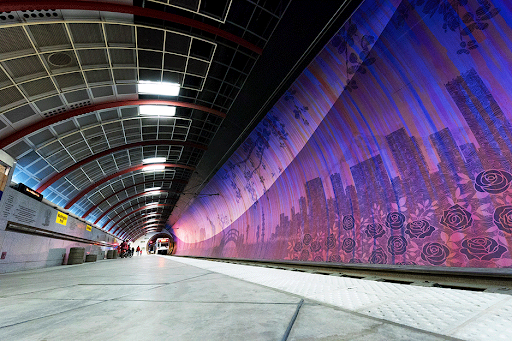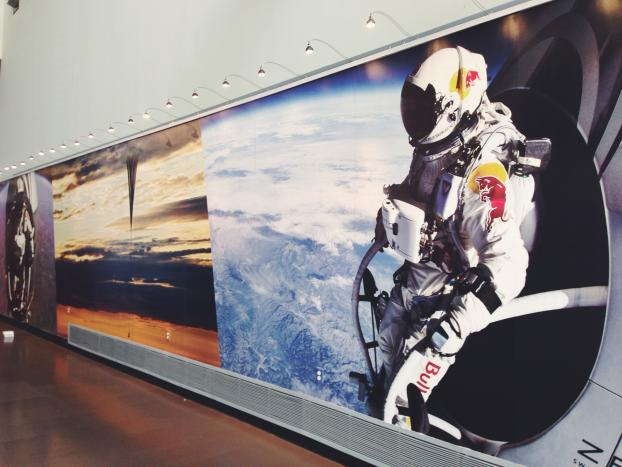All airline passengers have one thing in common when they’re in an airport: they need to get somewhere quickly and safely. Airport signs guide people through concourses and terminals. Signs also distract and entertain travelers and entice them to eat, shop or check out a local attraction.
Airport signage primarily falls into two categories: informational and promotional. SpeedPro can help airport managers develop strategies for both types.
What Makes Airport Signage Unique?
Airport signs have some unique requirements compared to other types of signs.
Universal language
Especially in international airports, signage needs to be clear and intelligible to anyone, regardless of their language. In addition to written text, symbols act as a universal language. For example, a sign with a fork and knife indicates dining areas, while the universal man and woman symbol directs travelers to restrooms.
Advertising opportunities
Airport signage increases sales for bars and restaurants in the airport. A well-placed banner as travelers are coming off the plane directs famished travelers to a nearby coffee shop. These signs attract customers who might otherwise go somewhere else during their layover.
Airport signage is also a great way to promote events or attractions in town, such as museums or arenas. People tend to look around for distractions while standing on the escalator or moving walkway, so eye-catching graphics may pique a traveler’s interest if they’re at their final destination.
Consistency
Airport signs help travelers quickly and easily navigate a busy airport, especially when trying to find their gate at a layover in an unfamiliar airport. An important aspect is that wayfinding and directional signs must have a common theme and repeating elements to familiarize people with them more easily. For example, green signs lead people to concourses and gates, while red signs direct people to baggage claim and ground transportation.
Types Of Airport Terminal Signage
Some of the most common types of universal airport signs include:
- Ticketing or Check-in
- Baggage Claim
- Gates
- Ground Transportation
- Can Rentals
- Restrooms
- Food
- Elevators
- Information (Desks or Directories)
- Parking
Wayfinding signs
Wayfinding signage tells passengers where they are and where they need to go. It has to be clear, concise, and easy for people unfamiliar with the airport layout to understand.
Safety signs
These signs tell people what they need to know in an emergency, such as where evacuation routes are located, what to do in case of fire or other disasters, etc.
Informational signs
Information signs give passengers information about their flight status, baggage claim location, restaurants and other amenities within the terminal.
Directional signs
Maps and directories provide the layout of the airport. Floor decals near escalators or elevators can also direct passengers when they get off. With so many people looking down at their phones these days, directional signs on the floor are a great addition to mounted and hanging signs.
Promotional signs
Airport advertising signs can be split into these two categories: airport advertising signage for stores and restaurants in the airport, and signs promoting local events and attractions in the city.
These signs may take the form of murals and wall wraps placed along walkways in terminals or concourses. They can highlight things like local landmarks or help build excitement around local events for travelers at their final destination.
Window graphics and banners promote retail stores and restaurants inside the mall. These can be fun graphics that draw people in or informational signs that display special offers, menus or amenities.
Digital displays
Digital displays communicate flight departure times, cities and countries, gates, and distance from checkpoints. They can also be used to communicate local weather conditions, distance to nearby attractions or wait time at ground transportation.
Airport Advertising Requirements
Airports have a lot of signage requirements, which doesn’t come as a surprise.
Most signs are installed with these requirements in mind during construction. These requirements involve location, visibility, legibility, format, frequency, color, mounting height, and continuity.
For example, ADA sign standards require a minimum height of 6 feet 8 inches for overhead signs on low ceilings and 8-10 feet at a high ceiling – so a person with limited sight can clearly see the signs.
Airport advertising and promotional signage have to conform to certain standards too:
- The design has to be minimal and non-invasive so that it won’t compete with wayfinding signs. Sign placing should be purposeful.
- Not a requirement, but signs can have visually intriguing elements that help people make better associations.
- Repeating designs and colors create memorable visual clues.
- Using symbols for a multi-lingual approach (see USDOT Symbols and Signs).
- Proper lighting that encourages the legibility of the signs and graphics
For a comprehensive list of requirements and recommendations, check out the FAA’s guidance on airport terminal and landside wayfinding, signing and graphics..
Why Work With A Professional For Airport Signage
Airport signage is one of the most critical aspects of an airport’s design. It prevents passengers’ confusion and delays and keeps them calm, cool and collected as they navigate large unfamiliar airports.
Strategically placed signage can also generate revenue for your airport when travelers have time to eat, shop and take advantage of amenities.
Working with a professional like SpeedPro will ensure your airport signage meets the needs of travelers while complying with FAA requirements.
Find your local studio today and schedule a free consultation to learn more about airport signs.









































